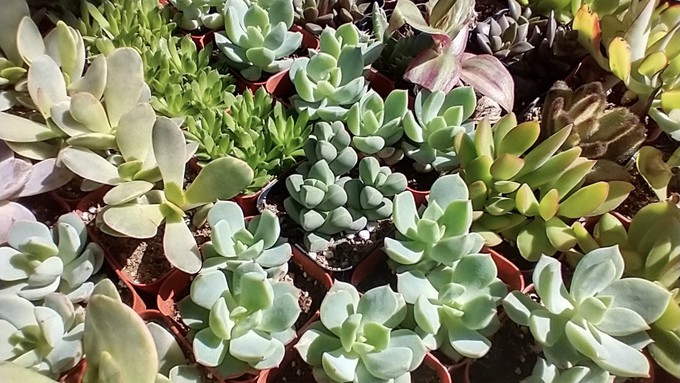
Sacramento Cactus and Succulent Society hosts big event featuring demonstration garden

Find cactus and succulent plants for sale during the Sacramento Cactus and Succulent Society show. Plants for sale were propagated by club members. Debbie Arrington
Looking for succulents? This plant event is so big, it stretches over three days!
Starting Friday, the Sacramento Cactus and Succulent Society hosts its 64th annual show and sale. Through Sunday, Shepard Garden and Arts Center will be packed with impressive specimen plants (for the show) and hundreds of baby plants (for the sale).
Admission is free. Come early for the best selection at the sale.
The club sells plants propagated by its members. In addition, many vendors from throughout Northern California will offer their plants as well as pots designed especially for cactuses and succulents.
Also find valuable advice on how to care for these low-water plants so they look their best. Cactuses and succulents can live for many years, sometimes decades.
In the show, club members will display some favorite plants from their own collections.
“The show will not be judged,” say the organizers. “Instead, we encourage club members at all levels to enter their plants to showcase the amazing variety of succulents.”
Expect to see plants you’ve never seen before – and now desperately want to add to your own garden.
While at Shepard Center, check out the succulent demonstration garden created and maintained by the club.
“(During the event), we would like to introduce people to our cactus and succulent demonstration garden on the north side of the Shepard Garden and Arts Center,” says club member Dave Roberts. “Originally started in 2018, we expanded the garden last year. This garden is meant to show people how to use cactus and succulents in their landscapes.”
Hours are 1-5 p.m. Friday, May 3; 9 a.m. to 5 p.m. Saturday, May 4; and 9 a.m. to 3 p.m. Sunday, May 5.
Shepard Center is located at 3330 McKinley Blvd., Sacramento, in the north end of McKinley Park. Free parking is available.
Details: https://www.sacramentocss.com/index.html.
Comments
0 comments have been posted.Sacramento Digs Gardening to your inbox.
Sites We Like
Garden Checklist for week of July 21
Your garden needs you!
* Keep your vegetable garden watered, mulched and weeded. Water before 8 a.m. to reduce the chance of fungal infection and to conserve moisture.
* Feed vegetable plants bone meal, rock phosphate or other fertilizers high in phosphate to stimulate more blooms and fruiting. (But wait until daily high temperatures drop out of the 100s.)
* Don’t let tomatoes wilt or dry out completely. Give tomatoes a deep watering two to three times a week.
* Harvest vegetables promptly to encourage plants to produce more. Squash especially tends to grow rapidly in hot weather. Keep an eye on zucchini.
* Pinch back chrysanthemums for bushy plants and more flowers in September.
* Remove spent flowers from roses, daylilies and other bloomers as they finish flowering.
* Pinch off blooms from basil so the plant will grow more leaves.
* Cut back lavender after flowering to promote a second bloom.
* It's not too late to add a splash of color. Plant petunias, snapdragons, zinnias and marigolds.
* From seed, plant corn, pumpkins, radishes, winter squash and sunflowers.